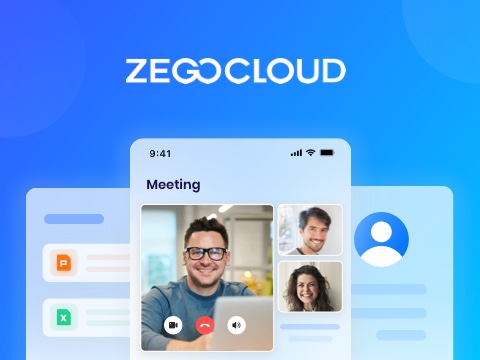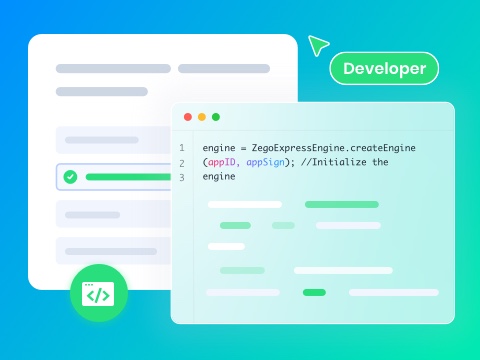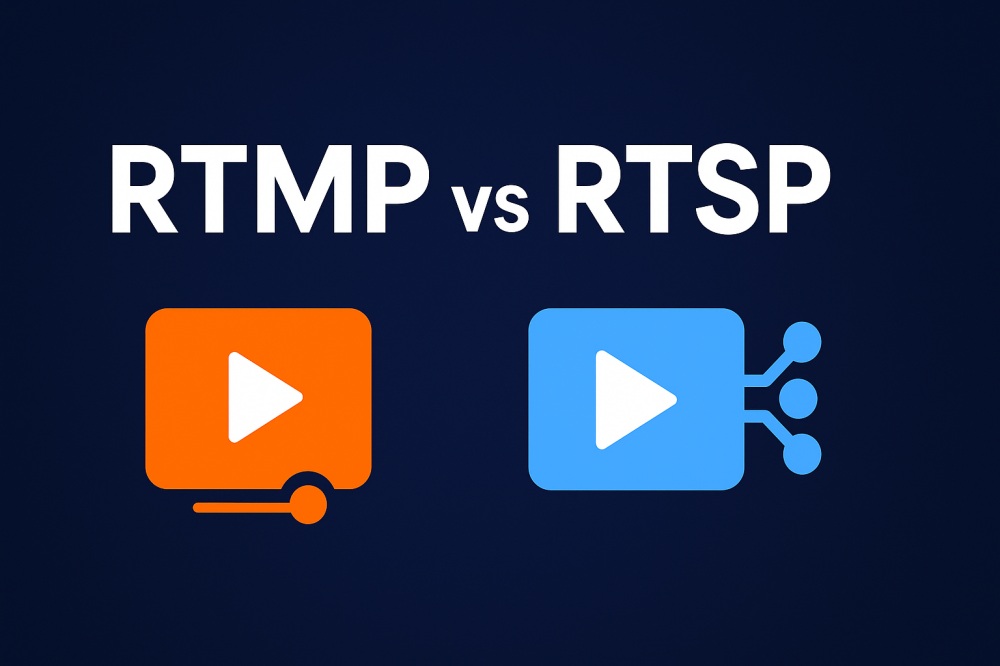Nowadays, it is confusing to select a proper streaming protocol, particularly when you need to provide a smooth live-streaming machine. The RTMP vs RTSP debate starts because these protocols serve different purposes but are often perceived as similar. Hence, whether you are building a scalable live broadcasting or deploying IP-based security systems, read this article comparing both protocols from every aspect.
What is RTMP (Real Time Messaging Protocol)?
RTMP (Real-Time Messaging Protocol), initially an Adobe and formerly a Macromedia protocol, is a TCP-based persistent-connection streaming protocol that distributes audio and video content. It was initially supposed to enable real-time messaging between an Adobe Flash Player and a server.
Nevertheless, this proprietary protocol has become a streaming industry standard and is reputed to provide the lowest latency content delivery, with nearly 5 seconds of delay. In addition to ensuring stable delivery of data, it transmits various data over a common connection.
Additionally, it offers adaptive bitrate streaming, thus the quality can be altered based on the network conditions at the viewer’s side. When comparing RTSP vs RTMP, note that the latter is widely adopted by encoders (such as OBS and FFmpeg) and live streaming platforms.
Use Cases for RTMP (Real-Time Messaging Protocol)
As RTMP is a popular choice for various streaming scenarios due to its reliability and low latency, here are its real-time use cases you must know:
1. Live Event Broadcasting
RTMP has the best real-time video delivery performance and the least latency, which makes it suitable to broadcast live events like concerts. Beyond that, popular streaming platforms such as YouTube Live (and Facebook Live) support RTMP as their key ingest protocol. In the RTMP vs RTSP debate, the earlier one ensures real-time social interactions with delays ranging from 2-5 seconds and sometimes sub-seconds via optimized servers.
2. E-Learning Webinars
It is a simple choice in virtual classrooms, remote training, and webinars because of interactive abilities (Q&A and chat). In addition, its bi-directional streaming feature helps educators to communicate, in real-time, with participants during an educational event. Moreover, learning platforms also take advantage of their adaptive bitrate support that optimizes stream quality depending on network circumstances and maintains the delivery.
3. Gaming & E-Sports
For live streaming gameplay, this real-time streaming protocol port, or RTMP, is the backbone because of its interactive and low-latency performance. Gamers in particular utilize RTMP and stream directly to sites like YouTube and Twitch, which provide real-time interaction with viewers. Moreover, platforms tend to convert RTMP streams into adaptive formats to increase their diffusion.
4. Corporate & Remote Communication
Currently, many companies use RTMP to enable secure internal communications, such as product launches and training (because it uses encryption protocols; RTMPE/RTMPS). Still, broadcasters implement it to stream to a limited audience or an internal CDN to ensure uniformity in the playback. In this case, token-authenticated administration and TLS encryption also assist them in safeguarding vital corporate broadcasts.
5. Surveillance & IP Streaming
Finally, while comparing RTSP vs RTMP, the former is the top choice of security applications, especially for IP cameras and surveillance systems. The reason is its sustained TCP connection and real-time video, which allows cameras and drones to monitor stations via RTMP servers. Moreover, its chunked transport ensures consistent live feeds, where optional adaptive bitrate buffering brings resilience in unstable networks.
What is RTSP Protocol (Real Time Streaming Protocol)?
Simply put, RTSP, real-time streaming protocol, refers to network protocols that control the streaming of media content on the internet. In addition, it helps in managing and setting connections across devices for audio and video streaming. Despite that, they let clients pause, play fast-forward, stop, and rewind streams, similar to a remote control with a VCR.
While the RTSP streaming protocol does not actually handle streaming of multimedia content, they do communicate with services delivering multimedia data. For example, when someone pauses or rewinds a live-streaming video, it sends a request to the video streaming services. However, know that although it has low latency, it isn’t widely compatible with platforms and has limited scalability.
Use Cases for RTSP (Real-Time Streaming Protocol)
Without downloading media files to the device, RTSP enables users to stream audio and video in various scenarios; some of the vital ones are as follows:
1. Video-on-Demand (VoD) Platforms
Compared with RTMP, real-time streaming protocol port (RTSP) allows VoD platform users to control playback during streaming, providing DVD-like control remotely. Besides, it supports interactive controls to improve users’ experiences when HTTP streaming delivers continuous content. Since it uses minimal bandwidth for control signaling when RTP handles the media delivery, it proves effective for corporate training, archives, and media houses.
2. Broadcast Contribution & Distribution
One uses it in internal broadcast systems for contribution feeds, particularly when live feeds from an event are being streamed within a central production facility. In the RTSP vs RTMP discussion, RTSP facilitates control for managing feeds while live broadcasts, including switching feeds for live editing. Ultimately, it benefits broadcasters regarding the protocol’s flexibility and capacity to integrate with RTP for consistent delivery.
3. Streaming for Embedded Devices
As RTSP can be integrated with numerous mobile and embedded devices for video streaming, remote users can manage sessions without overhead. Besides, while providing complete playback and switch quality controls, it enables streaming videos to monitoring centers or mobile apps. Furthermore, it proves effective in body-worn camera feeds for law enforcement, where stable streaming over varying network conditions matters.
4. Surveillance Systems
Security teams in IP systems and surveillance use RTSP to remotely control streaming playback and access continuous video delivery. Unlike HTTP streams, they contribute to interactive playback and camera control over networks, making them essential for public security. Also, RTSP streaming protocol’s multicast support assists in the same feed distribution across multiple monitoring sessions, ensuring a reliable surveillance infrastructure.
5. E-Learning Systems
Lastly, RTSP also enables interactive training with playback controls, which is especially useful in medical and technical training environments. Despite that, when RTSP-based systems are paired with RTP, they enable smooth and low-latency delivery. Thus, students and instructors can control their learning pace, mainly for remote labs and technical universities that use internal networks.
RTSP vs RTMP: Key Comparison
RTMP vs RTSP differs in several key aspects, including latency, compatibility, and use cases. Thus, to know about them in detail, adhere to the given comparison table:
| Feature | RTSP (Real-Time Streaming Protocol) | RTMP (Real-Time Messaging Protocol) |
|---|---|---|
| Developed By | RealNetworks & IETF | Macromedia (acquired by Adobe) |
| Purpose | Streaming media control protocol (start, pause, stop) | Real-time transmission of audio, video, and data |
| Transport Protocol | Mostly RTP over TCP/UDP | Uses TCP exclusively |
| Latency | Low latency is suitable for IP cameras and surveillance | Moderate latency is better for live broadcasts and streaming |
| Streaming Type | On-demand and live-streaming | Primarily live streaming |
| Compatibility | The RTSP streaming protocol works with media servers, IP cameras, and VLC, among other applications. | Initially designed for Flash Player, it is now used via a CDN. |
| Encoding Format Support | Container-agnostic (depends on implementation) | Typically uses the FLV container |
| Security | Can use RTSPS (RTSP over TLS) | Can use RTMPS (RTMP over TLS) |
| Use Cases | CCTV, IP camera feeds, low-latency remote monitoring | Live events, webinars, game streaming (before the HLS/CMAF era) |
RTMP vs. RTSP: Which Is Right for You?
When choosing between RTSP vs RTMP, know that the choice depends on the streaming goals, whether the goal is mass live broadcasts or low-latency local monitoring. Hence, if you seek to make a fine choice, go through the given aspects, highlighting the usage of each protocol:
1. Origin and Purpose
Regarding purpose, both protocols differ, as one utilizes RTMP for streaming videos over the internet on platforms like YouTube. If you desire to broadcast live content to large audiences, this option is dependable.
On the contrary, RTSP is used for IP cameras, CCTV systems, and private video monitoring. Thus, it makes this protocol ideal for surveillance or on-demand viewing, providing more control over the video, such as pausing and playing.
2. Transport Protocols
RTMP uses TCP, which makes sure that the video reaches the viewer without errors. Comparatively, RTSP streaming protocols divide videos into 2 categories, TCP and UDP, to achieve quick and low-latency streaming of videos. Therefore, when you require monitoring in real time with low latency, RTSP is the right choice. But RTMP is more suitable when it comes to stable broadcasting on a large scale.
3. Latency
Regarding latency, RTSP is a low-latency protocol, which implies that there will be no delay between what your camera captures and what appears on the screen. Nonetheless, RTMP is slower with a latency of about 2 to 5 seconds, unlike RTSP.
Therefore, RTSP is more suitable when you require real-time behavior in surveillance or monitoring. Although RTMP is suitable for streaming to many people, it is associated with a trade-off in terms of speed and scalability.
4. Playback and Compatibility
If you need a widely supported protocol, RTMP is a good option, as both streaming encoders (OBS) and media servers (Wowza) support it. The only disadvantage is that it is not compatible with the current browsers. Hence, RTMP streams need to be transcoded into HLS or DASH to deliver them to the end-user.
On the other hand, the RTSP real-time streaming protocol port is most compatible with such players as VLC, QuickTime, or even viewers specialized in surveillance. As it’s not supported natively in the browser, it makes this protocol less suited for mass online streaming.
5. Adaptive Bitrate and Scalability
When your goal is to reach a broad audience, RTMP works best, mainly when one pairs it with HLS or DASH for adaptive bitrate streaming. On the other hand, RTSP has no ABR, which is best for low latency and point-to-point setups like surveillance or internal monitoring.
6. Security
Finally, the last aspect that you should consider when choosing between RTMP vs RTSP is security. To encrypt data, RTMP makes use of RTMPS or RTMPE, and RTSP has RTSPS and SRTP. Thus, RTSP is recommended in sensitive or surveillance streaming, whereas RTMP is recommended in secure broadcasting to the general population.
From RTMP & RTSP to Real-Time: ZEGOCLOUD’s Streaming Solution
Right now, there is an ongoing debate between RTSP vs RTMP, but streamers don’t know that various real-time substitute exists. One such solution is ZEGOCLOUD, which features a live streaming API with a latency of 600ms. Moreover, unlike others, it lets streamers accommodate up to 10,000,000+ viewers with global coverage in 212 countries. Upon creating a room, they can enjoy live interactions with viewers along with watermark branding.
To address the pain points of RTMP and RTSP protocols, ZEGOCLOUD divides the streaming network into 3 phases. This includes CDN, Standard, and Premium Lives, each supporting latency between 3,000 ms and 1,000 ms. Additionally, this platform utilizes the RTC network, known as MSDN, to ensure optimal transmission quality. Not just that, a UDP-based proprietary transportation protocol caters to weak internet connections.
ZEGOCLOUD offers a set of features, including secure encryption protocols like RTMPS and SRTP. Hence, while availing of these aspects, streamers can use face beautification filters, letting them maintain visual appeal. Thus, streamers can also publish their content through a CDN, with recordings supported via ZEGOCLOUD’s VOD facility. What is more is that it supports multiple formats such as RTMP, FLV, HLS, and others.
Conclusion
Summing up, the RTSP streaming protocol is quite different from RTMP, catering to various needs. Thus, to know when and how to use a particular one, this article has explained these protocols in detail. However, we suggest ZEGOCLOUD, since it supports both RTMP and RTSP while offering ultra-low latency and global scalability.
FAQ
Q1: Is RTMP better than RTSP?
Not necessarily. RTMP (Real-Time Messaging Protocol) is better suited for browser-based and CDN live streaming, offering compatibility with platforms like YouTube and Facebook Live. RTSP (Real-Time Streaming Protocol), on the other hand, is ideal for IP cameras and real-time surveillance due to its low latency. The “better” protocol depends on your use case.
Q2: Is RTSP still being used?
Yes, RTSP is still widely used, especially in CCTV systems, IP cameras, and low-latency internal video applications. While it’s less browser-friendly, it remains popular in security and monitoring environments due to its efficiency and direct streaming capability.
Q3: How to convert RTSP to RTMP?
You can use media servers like FFmpeg, Wowza, Nginx with RTMP module, or MediaMTX to pull an RTSP stream and push it out as RTMP. This is a common setup when broadcasting from an IP camera to a public CDN.
Q4: Which protocol is better for streaming?
For most public or web-based live streaming needs, RTMP is preferred because it integrates smoothly with CDNs and has broad compatibility. For closed-circuit, low-latency environments like surveillance or internal networks, RTSP might be more efficient.
Let’s Build APP Together
Start building with real-time video, voice & chat SDK for apps today!










